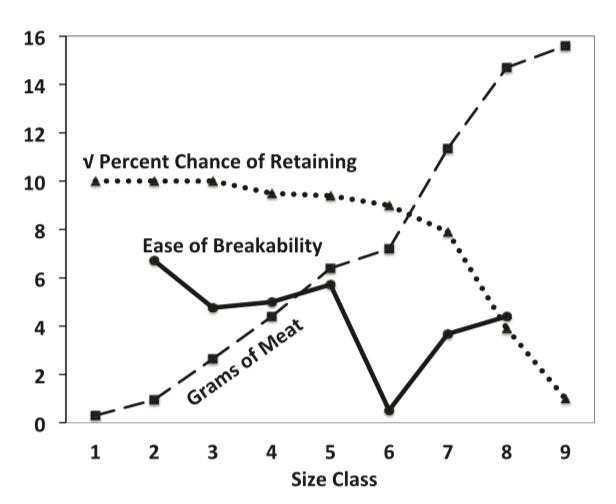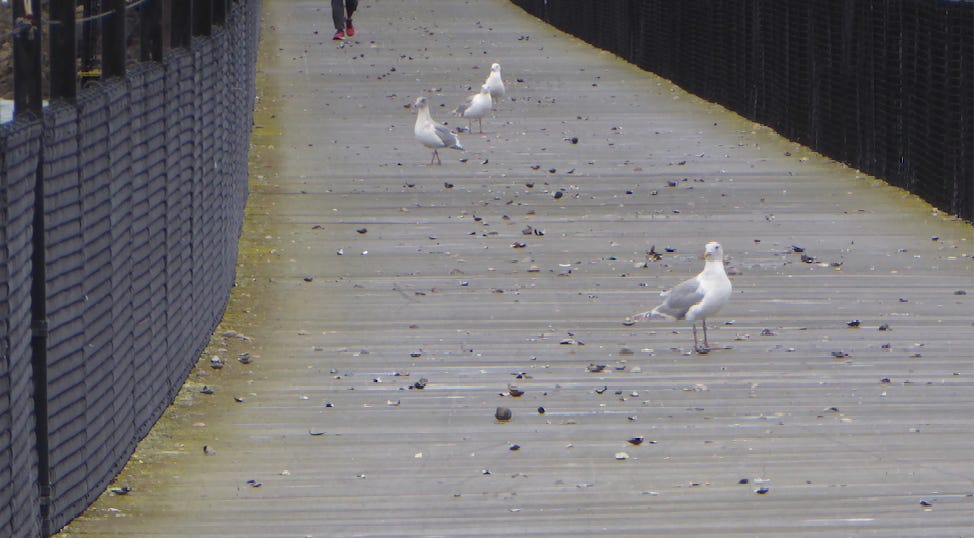One day early because of travel plans.
On our way up to Anacortes last week, to catch the ferry to Shaw and Lopez Islands, my wife and I stopped at the Tommy Thompson trail in Anacortes. If you’ve never been, the trail runs along an old train track for 3.3 miles. We had limited time so headed to the section that crosses the restored train trestle across Fidalgo Bay. Built around 1891, the trestle linked Anacortes to the east, at Weaverling Spit, which facilitated the movement of goods and people.
What interested me were the glaucous-winged gulls and their use of the trail as a nut cracker. Our first signs of how the birds took advantage of the hard surface, which was mostly wood slats, were the broken clam shells. We didn’t see any birds at first but then we saw a gull fly over, hover slightly, and drop a clam, which didn’t break. But following that adjacent imperative—pick up, drop, repeat—the gull tried again.
For decades, ornithologists have described this curious behavior of gulls. One study in the San Juan Islands and at Seattle’s Golden Gardens park found “an age-related progression of increased clam-slamming efficiency.” Apparently, clam dropping is learned behavior. As birds get older, experience leads to them dropping clams from higher heights, adjusting their drop height based on prey weight, and choosing harder substrates, such as parking lots and railroad trestles, instead of mudflats. They also tend to fumble fewer airborne clams and are more efficient in choosing clams that are relatively easier to break and provide more meat. In scientific speak, “discrimination of profitable prey sizes takes longer to perfect.”

At least nine species of gulls take advantage of gravity and Newton’s laws of thermodynamics to obtain a meal. (See below for explanation.) They are joined by 15 other birds, particularly species in the corvid family, such as ravens, rooks, and crows.
In one study of crows focused on size, substrate, drop height, and prey loss, the crows acted similarly to gulls but went a step further by adjusting their drop height in relation to how many times they had dropped the walnut. In other words, they realized that they were weakening the walnut shell and didn’t need to spend the energy to reach the original drop height. They also lowered drop height if other crows who might steal a meal were nearby; being lower to the ground increased the likelihood of eating the meal they were preparing. (So honey, what are you doing today? Oh, just going out to watch crows drop walnuts. Ah, the life of a scientist!)
But, as in any situation, sometimes bad things can happen when animals utilize this technique. Legend has it that the great Greek poet of tragedies, Aeschylus (c. 525 BCE – c. 456 BCE), died because an eagle or a vulture known as a lammergeyer mistook the poet’s bald pate for a rock and dropped a turtle on him. Ironically, according to Pliny the Elder, Aeschylus was outside that day because “an oracle, it is said, had predicted his death on that day by the fall of a house.” So, friends be careful out there.
My last scheduled guided walk of the year will be on Saturday, October 2, at 1pm. Once again, I will be with my pal Cambria and The Field Trip Society. We’ll be downtown exploring the human and natural history of building stones.
And, as always, this newsletter is free, if you want to subscribe.
The science of the clam slam, as explained by a friend. “The clam of a particular mass has a particular gravitational potential energy based on its height. As the clam drops, the clam gains kinetic energy based on its mass and acceleration, minus the losses as friction heats the air; it loses gravitational potential energy as height goes to zero. Upon impact, the kinetic energy is converted into heat in a variety of ways, like bouncing, bending, or breaking the clam or the ground, or heating the air with sound waves, unless it bounces up onto a rock, in which case some of the kinetic energy is converted back into gravitational potential energy. The impact force is calculated using Newton's second law and because of Newton's third law, the ground acts as a hammer with an equal and opposite force on the clam.” By the way, I could never have written this; in college I got an 11% on a 2-hour physics quiz.








I lived on Whidbey for quite a long time, and am very familiar with clam slamming! Or mussel slamming, as the case may be. Nothing like having a mussel hit your windshield as you drive under just as a bird drops its meal. Fortunately the windshield was fine. This activity is really common around the Monroe Landing area, both gulls and crows are often seen busy dropping things on the road.
Thanks...or rather THANKS. Again. I’ve sent this on to family n friends, coast-to-coast for bits of history, geography, ornithology, physics.